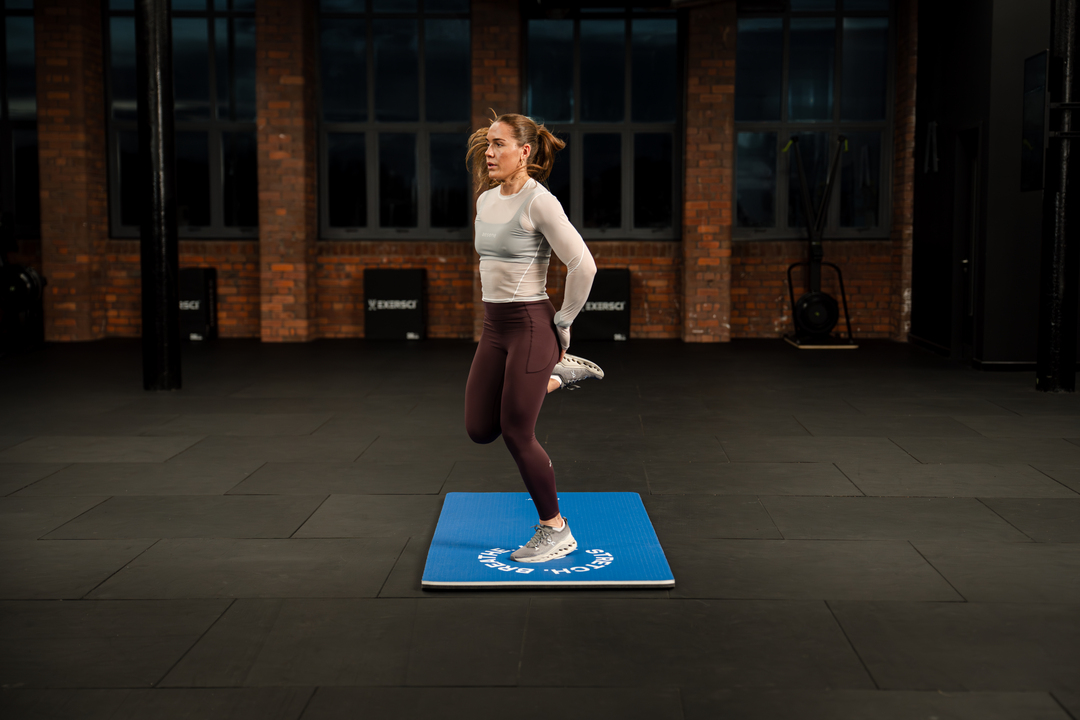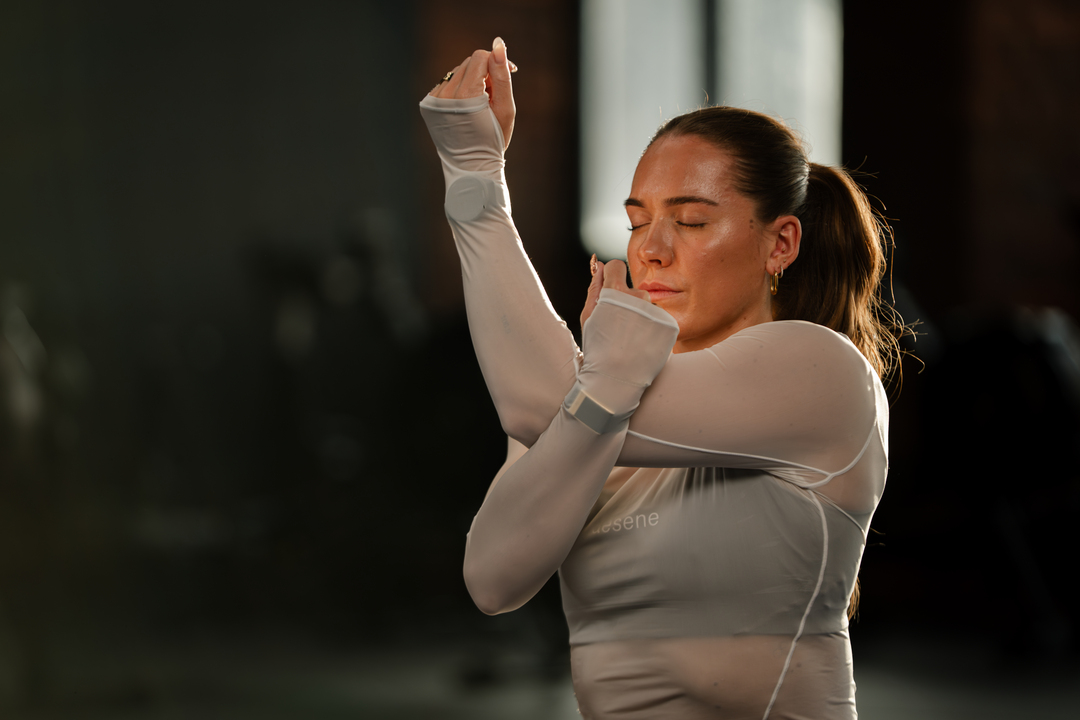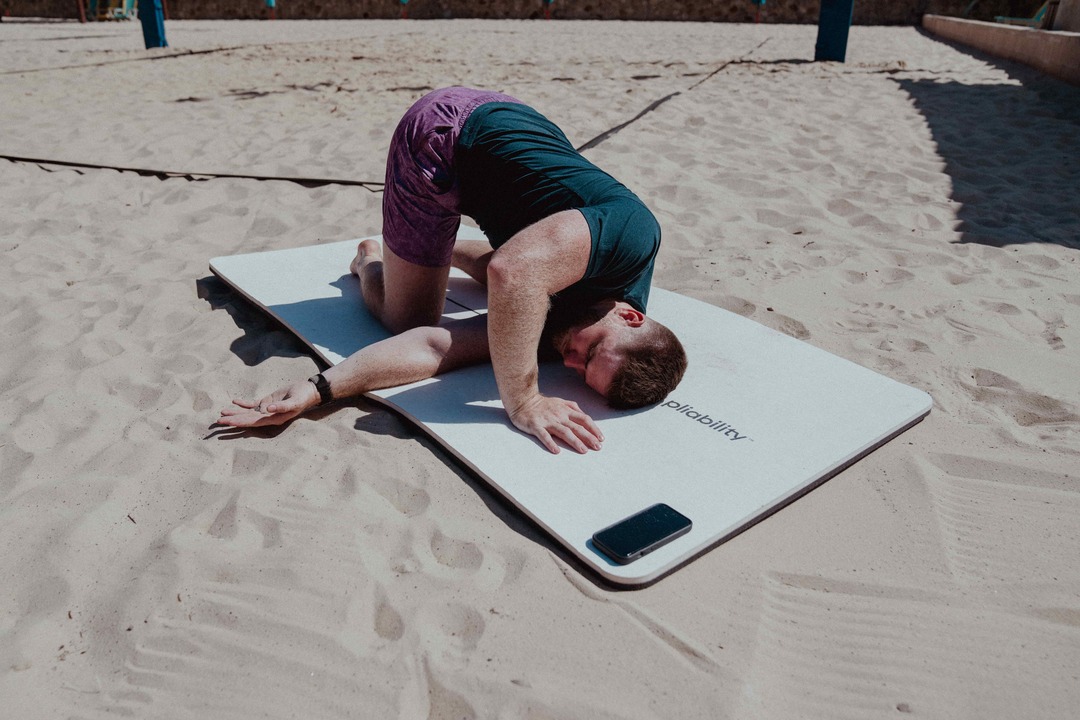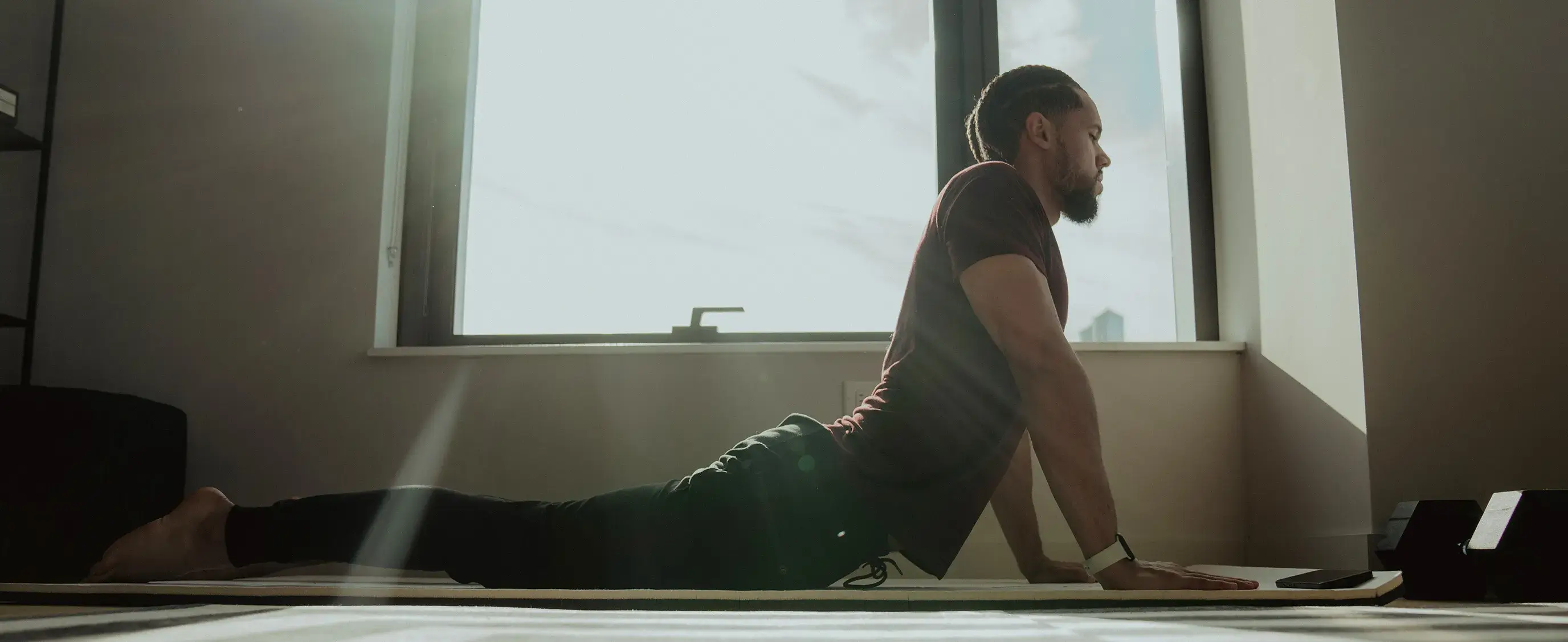When was the last time you noticed your hamstrings? These two muscles on your thighs don't get much attention until things go wrong. Tight hamstrings can limit your performance in sports and the gym, and they can cause pain and discomfort during everyday activities like climbing stairs or getting out of a car. Hamstring mobility exercises can help you avoid these issues by improving flexibility and performance. In this article, we'll go over the best hamstring mobility exercises so you can stay agile, prevent injuries, and enhance your workout performance.
To speed up your progress, check out Pliability's mobility app for guided routines and recovery programs led by professional athletes and their trainers.
The Importance of Hamstring Mobility
Your hamstrings comprise three separate muscles:
- Biceps femoris
- Semimembranosus
- Semitendinosus
They are crucial parts of your posterior chain or the muscles that run along the back of the body from head to toe.
Dane Miklaus, CSCS, CEO and owner of Work training studios in Irvine, California, and Meridian, Idaho, tells self that they help you extend your hips and flex your knees, movements that allow you to do everything from standing upright and bending forward to walking, running, and jumping.
Why Hamstring Mobility Matters for Performance
Limited hamstring mobility can lead to compensatory movement patterns that increase the risk of strain or injury. Research shows that improving hamstring flexibility can help reduce your risk of injury, especially in sports involving sprinting, jumping, and quick direction changes.
As you increase your range of motion and strengthen your hamstrings, you help them stabilize your knee and function better during activities, which can help prevent painful injuries.
What Causes Tight Hamstrings?

Poor posture can lead to tight hamstrings, especially when seated. If your pelvis is tilted too far forward, as is often the case when seated, this puts your hamstring into a lengthened and weakened position. “It will feel ‘tight,’ but it’s long,” explains physical therapist Luke Worthington. “It’s important to strengthen rather than lengthen your hamstrings.”
Genetics Matters
Some people are naturally more limited in their hamstring flexibility. Genetics can make you predisposed to tighter hamstrings.
Sports and Activities that Stress the Hamstrings
Some sports and workouts can contribute to hamstring tightness. Activities that require repetitive sprints or sudden direction changes can overstress your hamstrings and cause chronic tightness. Football, netball, HIIT, and some forms of circuit training are prime examples.
Sitting is the New Smoking
Having an office job is the perfect culprit for causing tightness, because sitting at a desk for long stretches (no pun intended) of time shortens your hamstring muscles.
Pliability: Enhancing Your Fitness and Mobility

If you're feeling limited by pain or your ability to move, Pliability aims to:
- Complement your existing fitness routine
- Help you move better
Sign up today for seven days free on iPhone, iPad, Android, or our website to use our mobility app to improve flexibility, aid recovery, reduce pain, and enhance range of motion.
Related Reading
- Ankle Mobility Exercises
- Shoulder Mobility Exercises
- Hip Mobility Exercises
- How To Improve Flexibility
- Thoracic Mobility Exercises
- Stretch Before Or After Workout
- Wrist Mobility Exercises
- Mobility Exercises For Beginners
- Best Stretching Routine
- Back Mobility Exercises
- Lower Body Mobility Exercises
- Leg Mobility Exercises
- Mobility Exercises For Athletes
Tight Hamstrings Symptoms

Tight hamstrings can cause all kinds of discomfort. The symptoms can vary from person to person, but they often include:
1. Back Thigh Tightness
People may notice a feeling of tightness in their posterior (back) thigh and difficulty getting into some positions due to this tightness, usually bilaterally (on both sides, since 'bi' means 'two' and 'lateral' means 'side),' says Knapton.
2. General Thigh Tightness
You may also find that you're unable to sit with your legs out straight due to a muscle restriction. This is usually felt centrally in the back of your thigh.
3. Back Pain
Tight hamstrings can increase your risk of injury. Sometimes, they're accompanied by other symptoms, like swelling, tenderness, bruising or cramping. Tightness can also be worse after working out.
4. Sciatic Pain
Sciatic pain can occasionally present as a hamstring problem, so it's important to seek appropriate care if you're unsure.
5. Knee Pain
Do tight hamstrings cause back and knee pain? They can. Tight hamstrings can pull your pelvis
down in a condition called posterior pelvic tilt, flattening the curve in your lumbar spine and making it look like you're tucking your glutes under. This can lead to:
- Lower back pain
- Knee pain
- Upper-back tension,
- Rolled-forward shoulders
The Benefits of Regularly Exercising Your Hamstrings
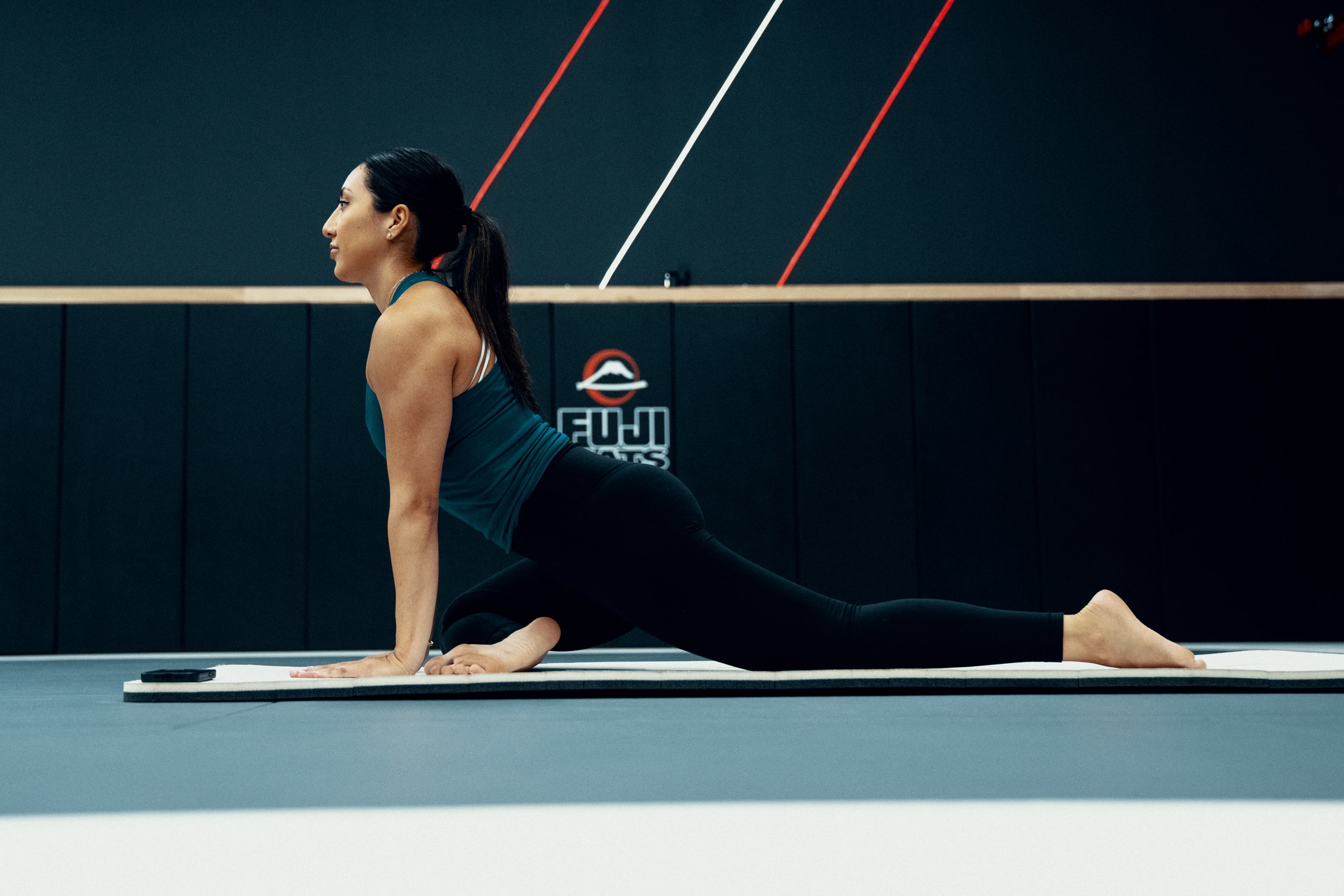
1. Boost Athletic Performance with Hamstring Mobility Exercises
Strengthening and stretching the hamstrings can enhance athletic performance, prevent injury, and improve posture. Flexible hamstrings offer many perks, says Taylor Pfeifer, DPT, CSCS, and multiunit owner with FYZICAL Therapy & Balance Centers. They can enhance your performance by improving your range of motion during workouts. “This increased flexibility can also contribute to better posture and reduced muscle tension, making day-to-day movements smoother such as squats, lunges, or hip hinge patterns,” he says.
Pfeifer says flexible hamstrings help alleviate common aches and pains, especially in the lower back and foot. “Studies show that tight hamstrings can change the mechanics of the foot, leading to plantar fasciitis or Achilles tendinopathy,” he adds.
2. Injury Prevention with Hamstring Mobility Exercises
Shoemaker says hamstring flexibility allows a full range of movement for injury prevention. “When our hamstrings are overly tight, you will rely too much on other muscle groups, which can leave the hamstrings prone to injury through strain and promote injury to other muscle groups through overuse,” she says. This carries over into daily tasks such as:
- Vacuuming
- Shoveling snow
- Raking leaves
“With limitations in hamstring flexibility or length, you also risk direct hamstring injury or indirect injury through strain to the hips, lower back, or knees,” she adds. Runners and cyclists can also reduce exposure to injury if they engage in regular hamstring stretches to improve flexibility.
3. Better Hamstring Mobility Leads to Improved Posture
What’s more, Shoemaker says improving your hamstring flexibility may also lead to improved power. “For example, a cyclist will be much more powerful if they can use their hamstring length to propel themselves fully, versus the cyclist with tight hamstrings who just may rely on their quadriceps to power their pedal stroke. A runner will have better performance if they have their full hamstring length through improved power in their gait,” she says.
27 Hamstring Mobility Exercises to Supercharge Your Workouts

1. Romanian Deadlift
- Stand with your feet hip-width apart, knees slightly bent, and your arms relaxed by the front of your quads, with a dumbbell in each hand. This is the starting position.
- Hinge forward at your hips and bend your knees slightly as you push your butt way back. Keeping your back flat, slowly lower the weight along your shins. Your torso should be almost parallel to the floor.
- Keeping your core engaged, push through your heels to stand up straight and return to the starting position. Keep the weight close to your shins as you pull.
- Pause at the top and squeeze your butt. That’s 1 rep.
The deadlift is a hip-hinge movement pattern, meaning your hamstrings and glutes are the main drivers here.
2. Single-Leg Deadlift
- Stand with your feet together, holding a dumbbell in each hand in front of your legs. This is the starting position.
- Shift your weight to your left leg and, while keeping a slight bend in your left knee, raise your right leg straight behind your body, hinging at the hips to bring your torso parallel to the floor, and lower the weight toward the floor.
- Keep your back flat. At the bottom of the movement, your torso and right leg should be almost parallel to the floor, with the weight a few inches off the ground. (If your hamstrings are tight, you may not be able to lift your leg as high.)
- Keeping your core tight, push through your left heel to stand up straight and pull the weight back up to the starting position. Bring your right leg back down to meet your left, but try to keep the majority of the weight on your left foot.
- Pause there and squeeze your butt. That’s 1 rep. Complete all your reps on one side, then switch sides.
The single-leg deadlift, which works your hamstrings and glutes, requires a lot of balance. If you struggle with that, use one dumbbell instead of two, and lightly touch a wall or sturdy object to keep yourself steady.
3. Kickstand Deadlift
- Stand with your feet hip-width apart, holding a dumbbell in each hand.
- Place one foot a foot-length behind the other, heel elevated (as shown above), so your stance is staggered. You’ll be working your front leg.
- Hinge at your hips to lower your body. Push your butt far back and keep your back flat. Your torso should be almost parallel to the floor.
- Keeping your core tight, push through your front heel to stand up straight. Keep the weights close to your shins as you pull up.
- Pause at the top and squeeze your butt. That’s 1 rep
- Complete all your reps on one side. Then switch sides and repeat.
The kickstand deadlift is a deadlift variation that focuses on unilateral, or single-leg, strength. Because your back foot remains on the ground for balance, keeping yourself steady is not as tricky as it is with the single-leg deadlift, making this move a great stepping stone to help you get there!
4. Kettlebell Swing
- Make a triangle with a kettlebell and your feet, with your feet at the bottom of the triangle and the kettlebell about a foot in front of you at the top of the triangle.
- With a soft bend in your knees, hinge forward at your hips, push your butt back, and grab the handle with both hands. Tilt the bell on its side, handle toward your body.
- Hike the bell high up in your groin area (your wrists should touch high in your inner thigh) and thrust your hips forward aggressively so that at the top of the swing, you are essentially in a standing plank, looking straight ahead, squeezing your core, glutes, and quads.
- Once the bell reaches about chest height (and not above shoulder height), hinge forward at your hips and push your butt back again, letting the bell drop on its own as you do. You should not feel like you're using your arms to lift anything. Let your eyes, head, and neck follow so that you don't strain your neck. This is 1 rep.
- When you're done with all of your reps, perform a back swing to safely put the weight down: Bring the bell through your legs, but instead of thrusting your hips forward to bring it to shoulder level, place it back on the floor. The kettlebell swing builds posterior chain strength and trains explosive movement.
5. Single-Leg Hamstring Curl
- Loop a resistance band around the soles of both feet. Lie face down on a mat with your legs extended and arms folded in front of you.
- Engage your glutes and curl one leg up toward your butt. Make sure to keep the other leg stationary.
- Slowly lower the leg back to the starting position. This is 1 rep
This unilateral exercise really isolates your hamstrings while stretching the front of the hips and quads.
6. Bulgarian Split Squat
- Stand with your back to your “bench.” With your left foot on the floor a few feet in front of the bench, place the top of your right foot on the bench, shoelaces down.
- Place your hands behind your head and engage your core. You can also clasp your hands at your chest or leave them at your sides if that feels more comfortable.
- Bend your knees to lower down into a split squat. Your left knee should ideally form a 90-degree angle so that your thigh is parallel to the ground and your right knee is hovering above the floor.
- (Quick position check: Your left foot should be stepped out far enough to do this without letting your left knee go past your left toes. If you can’t, hop your left foot out a bit farther away from the bench.)
- Driving through your left heel, stand back up to the starting position. Continue performing reps, switching sides when they’re completed.
The Bulgarian split squat puts more of an emphasis on the hamstrings than the OG split squat, and it adds in some extra stability work to challenge your core. It’s a more advanced move, so make sure you’ve mastered a split squat with both feet on the floor before trying it.
7. Weighted Glute Bridge
- Lie on your back with your knees bent and feet flat on the floor, hip-width apart. Hold a dumbbell in each hand, resting them right under your hip bones. This is the starting position.
- Squeeze your glutes and abs and push through your heels to lift your hips a few inches off the floor until your body forms a straight line from your shoulders to your knees.
- Hold for a second and then slowly lower your hips to return to the starting position. This is 1 rep.
- For extra hamstring activation, bring your feet slightly farther away from your butt, Miklaus says. Make this exercise easier by using just your bodyweight.
8. Marching Glute Bridge
- Lie faceup with your knees bent and your feet hip-width distance apart.
- Engage your core so your low back presses against the floor. From this engaged position, lift your hips, squeezing your glutes at the top. Hold here.
- Lift your right foot off the floor, bringing your knee toward your chest and stopping when you've hinged your hip to about 90 degrees.
- Replace your foot on the floor and immediately lift your left foot off the floor to repeat on the other side.
- Continue to march, alternating your feet, all while maintaining lifted hips.
The dynamic nature of the march brings on an extra cardio challenge to this single-leg strength exercise.
9. Single-Leg Glute Bridge
- Lie on the floor faceup with your knees bent and feet flat on the floor, hands at your sides. Engage your core to press your low back against the floor.
- From this position, lift your right foot off the floor and extend your leg.
- Push off your left foot, engage your core, and squeeze your glutes as you lift your hips and do a glute bridge.
- Slowly lower your hips back to the floor. That’s 1 rep.
- Do all of the reps on one side, then repeat on the other.
Again, if you really want to zero in on hamstring strength, move the foot on the floor slightly farther away from your butt.
10. Good Morning
- Stand with your feet hip-width apart with your hands at your ears. For an added challenge, you can place a weighted bar or barbell on your back.
- Keeping a soft bend in your knees, hinge forward at the hips and push your butt back as you fold your torso forward. Stop when your torso is just above parallel to the floor.
- Drive your hips forward as you lift your torso back up and return to the starting position. Squeeze your glutes at the top. This is 1 rep.
This exercise really smokes your posterior chain muscles, including your glutes, erector spinae, and lower back muscles, as well as your hamstrings.
11. Reverse Lunge
- Start standing with your feet shoulder-width apart. This is the starting position.
- Lift your right foot and step back about two feet, landing on the ball of your foot and keeping your heel off the floor.
- Bend both knees until your left quad and right shin are approximately parallel to the floor.
- Your torso should lean slightly forward so your back is flat and not arched or rounded.
- Your left knee should be above your left foot, and your butt and core should be engaged.
- Push through the heel of your left foot to return to the starting position. That's 1 rep.
- Do all your reps on one side, then repeat with the other leg.
While lunges are more knee-dominant, the reverse lunge hits your backside muscles more, since your hamstrings and glutes need to fire for stability.
12. Sumo Squat
- Stand with your feet wider than shoulder-width apart, toes turned out about 45 degrees. Hold one weight with both hands on one end so it's hanging vertically. This is the starting position.
- Bend your knees and push your hips back as you lower down into a squat.
- Drive through your heels to return to standing and squeeze your glutes at the top. That’s 1 rep.
Make this exercise easier by using just your bodyweight. While the squat is more of a knee-dominant exercise, the wider stance here encourages your inner hamstring muscles to fire more.
13. Standing Glute Kick-Back
- Loop a resistance band around your ankles and keep your knees softly bent. Put your hands on your hips. You can also stand in front of a wall and touch it lightly for balance.
- With your glutes engaged, slowly extend one leg out behind you. Don’t arch your back. Carefully bring your leg back down. This is one rep.
- Complete all your reps on this leg. Repeat on the other leg.
This move is meant to target the glute muscles on the moving leg, but it also requires a lot of hamstring engagement. Make it easier by removing the band; make it harder by using a stronger band.
14. Hip Thrust
- Sit on the floor with your back to a bench (or a sturdy step or even your couch). Bend your knees and place your feet flat on the ground, hip-distance apart.
- Rest your upper back on the edge of the bench and place your dumbbells on your lap. (You can use one or two, depending on size and comfort of the weights.) This is starting position.
- Drive through your heels to lift your hips up toward the ceiling, keeping your upper back in place against the bench.
- Pause and squeeze your glutes at the top.
- In a slow and controlled motion, lower your butt back toward the ground. This is 1 rep.
Like with the bridging exercises, moving your feet farther from your butt will hit your hammies a little harder, says Miklaus. If dumbbells feel too easy, you can do this with a barbell. Too hard? Do this exercise with just your bodyweight.
15. Donkey Kick
- Start in an all-fours position, with your wrists under your shoulders, knees under your hips, and core engaged.
- Kick your right foot up and toward the ceiling, engaging your glutes and using your hamstrings to pull your foot upward.
- Keep your core engaged so you stay stable and don't tip to the left. Stop lifting before you arch your low back.
- Return your leg to the starting position. This is 1 rep.
- Do all your reps on one side, and then repeat on the other leg.
As you lift your leg, keep your entire backside engaged so that you get the most from your glutes and hamstrings. To make it harder (and naturally engage the hammies more), place a light weight in the crease of your knee and squeeze your leg to hold it in place.
16. Partner Nordic raise
“The Nordic raise is a classic hamstring exercise that can be easily adjusted to progress as you get stronger,” says Harbage. “It’s fantastic for injury rehabilitation and no equipment is needed.’’ “Kneel down with your body upright and have your partner place their hands on your ankles to keep them on the floor. Keeping your torso as straight as possible, lower your chest and hips down to the ground. Then pull yourself back up using your hamstrings.’’
“Most beginners will need to perform a kneeling press-up to get back up, because these are tough. Make sure to lower slowly and go as low as you can before assisting with the hands. As you get stronger, use less and less upper-body assistance.”
17. Lying Hamstring Stretch Using a Strap
- Lie flat on the ground or a mat with the legs stretched out.
- To stretch the right leg, bend the right leg and place the strap across the ball of the right foot.
- Hold the strap in both hands.
- Keep the left leg extended on the ground with the foot flexed. This should push the thigh and calf toward the floor.
- Slowly extend the right leg with the foot flexed. The right leg should be straight with a slight bend in the knee. The bottom of the foot should face the ceiling.
- Gently pull the strap until there is a slight tension in the hamstrings.
- Hold the stretch for 10–30 seconds.
- Switch legs. Repeat 2–4 times on each leg.
18. Lying Hamstring Stretch Using a Wall
- Find an open doorway.
- Lie flat on the ground or a mat, with the back flat and the left leg fully extended on the floor. The left leg should pass through the doorway.
- Lean the right leg against the wall next to the doorway.
- Adjust the distance between the body and the wall to achieve mild tension in the right leg.
- Hold the stretch for 10–30 seconds.
- Switch legs. Repeat 3 times on each leg.
19. Sitting hamstring stretch
- To stretch the right leg, sit on the ground with the left leg bent at the knee with the foot facing inward. This is called the butterfly position.
- Extend the right leg, keeping it slightly bent at the knee.
- Bend forward at the waist, making sure to keep the back straight.
- Hold the stretch for 10–30 seconds.
- Switch legs. Repeat 2–3 times on each leg.
20. Sitting hamstring stretch using a chair
- On a chair, sit near the edge of the seat with the back straight.
- Keep one foot flat on the floor.
- Stretch the other leg out in front and rest it on a chair.
- Slowly bend the trunk forward until there is an obvious stretch at the back of the thigh.
- Ensure the spine is in a neutral position and the shoulders do not hunch forward.
- Hold the stretch for 10–30 seconds.
- Switch legs. Repeat 2–4 times on each leg.
21. Standing hamstring stretch
- Stand upright with the spine in a neutral position.
- Place the right leg in front of the body with the foot flexed, the heel pushed into the ground, and the toe pointing toward the ceiling.
- Slightly bend the left knee.
- Gently lean forward and place the hands on the straight right leg.
- Keep a neutral spine.
- Hold the stretch for 10–30 seconds.
- Switch legs. Repeat 2–4 times one each leg.
22. Standing hamstring stretch using a table
- Find a table that is just shorter than hip height.
- Stand upright with the spine in a neutral position.
- Place the right leg on the table with the foot flexed so the toes point toward the ceiling. Stand far enough away from the table so that only the foot and part of the calf rest on the table.
- Bend forward at the waist until there is a stretch in the hamstring muscle.
- To increase the intensity of the stretch, bend forward slightly, placing the hands on the leg or the table for support.
- Hold the stretch for up to 30 seconds.
- Wait 15 seconds between each repetition, then repeat 3 times on each leg.
23. Foam roll hamstring stretch
- Sit on the floor with the legs stretched straight in front.
- Place the foam roll flat under the hamstring of one leg and fold the other leg with the foot flat on the floor.
- Raise the buttocks off the mat while maintaining balance with the hands flat on the floor.
- Move the body back and forth in long, sweeping movements, stopping just short of the back of the knee.
- Lightly twist the thigh to make sure the roller goes over the right, left, and middle of the hamstring muscle.
- Switch legs and repeat the stretch.
- Benefits of hamstring stretches
- Hamstring stretches can keep the hamstrings loose and flexible
24. Towel Hamstring Stretch
The towel hamstring stretch, Verywell / Ben Goldstein. Most folks have towels to perform towel stretches, although you can use a strap or belt instead.
- Lie on the floor on your back.
- Loop a long bath towel around your toes and hold the ends of the towel in both hands.
- Slowly pull on the towel to lift your straight leg up. Be sure to keep your knee straight. The leg without the towel should remain flat on the ground.
- Bring your leg up until you feel a stretch behind your thigh. You may also feel a stretch in your calf. This is normal.
- Hold for 15 to 30 seconds, and then relax.
- Repeat three to five times on each leg.
Remember that the towel hamstring stretch should feel good as you are doing the exercise; if it causes pain, stop immediately and try something else.
25. Standing Forward Bend
The standing forward bend is an easy hamstring stretch that allows gravity to help deepen the stretch. If your low back is sore, proceed with caution or choose a different stretch.
- Stand up straight with your arms overhead.
- Fold forward from the hips, reaching your hands toward the floor. Your hips should be stacked over your ankles. Touching your toes is not the goal of this stretch. Only go as far as you can without overly bending your knees (they can be ever-so-slightly bent, but don't bend them to try to go lower, because your hamstrings will not get the stretch).
- Notice your quadriceps, the muscles at the front of your thighs. Engage your quads to deepen the stretch of the hamstring.
- Hold for 15 to 30 seconds.
- Bring your upper body back to a standing position.
26. Walk the dog
- Come onto the floor, on your hands and knees
- Set your knees below your hips and hands slightly forward from your shoulders
- Lift your knees of the floor and push your hips up towards the ceiling
- Start ‘walking’ your feet up and down slowly, stretching your heels onto the floor
- Keep the movement going for about 1 minute
27. Extended Triangle Pose
- Start in a standing position. Then move your legs about three to four feet apart.
- Reach your arms out parallel to the ground with your palms facing down.
- Turn your right foot in toward the left and your left foot out 90 degrees. Keep your heels in line.
- Slowly bend your torso over your left leg and reach your left hand to the floor or a yoga block for support. Stretch your right arm toward the ceiling.
- Hold for 30 to 60 seconds, or however long your instructor directs you to.
- Repeat on the other side.
When to Do Hamstring Stretches

The science behind stretching your hamstrings is all about timing. Dynamic stretches that increase blood flow and improve the function of your hamstring muscles are best before a workout. Peloton instructor Hannah Corbin also likes to foam roll the hamstrings before a workout.
Static stretches are best saved for the end of a routine when your muscles are warm. This type of stretching can help improve hamstring flexibility and range of motion while also reducing muscle soreness. “I always encourage people to be very gentle with their post-workout stretches because we’ve asked the muscles to perform for us and they need a little patience,” Hannah says.
Benefits of Incorporating Hamstring Stretches into Daily Routines
If you work at a desk or spend long hours sitting, take breaks to stretch your hamstrings. Prolonged sitting can contribute to tightness, so incorporating stretches throughout the day can be beneficial.
Another good time to do hamstring stretches is during a regular yoga or flexibility routine. You may also find that gentle stretching before bedtime helps relax your muscles and promotes better sleep. Just remember to perform stretches gently and gradually, avoiding any sudden, jerky movements. And if you have existing injuries or health concerns, it's advisable to consult with a healthcare or fitness professional before starting a new stretching routine.
Don’t Skip the Cool Down: Why Hamstring Mobility Exercises are Crucial for Recovery
After a workout, it's easy to throw in the towel and call it a day, but taking the time to cool down and stretch is essential for recovery, especially if you want to prevent tight hamstrings. "If you don't take the time to stretch and recover, your muscles can become tight, which may increase your risk of injury," explains Corbin.
"Static stretches for the hamstrings are a great way to improve flexibility and range of motion while decreasing muscle soreness." Integrating hamstring stretches into your cool-down routines can help prevent tightness from prolonged activity.
Pliability: Enhancing Your Fitness and Mobility
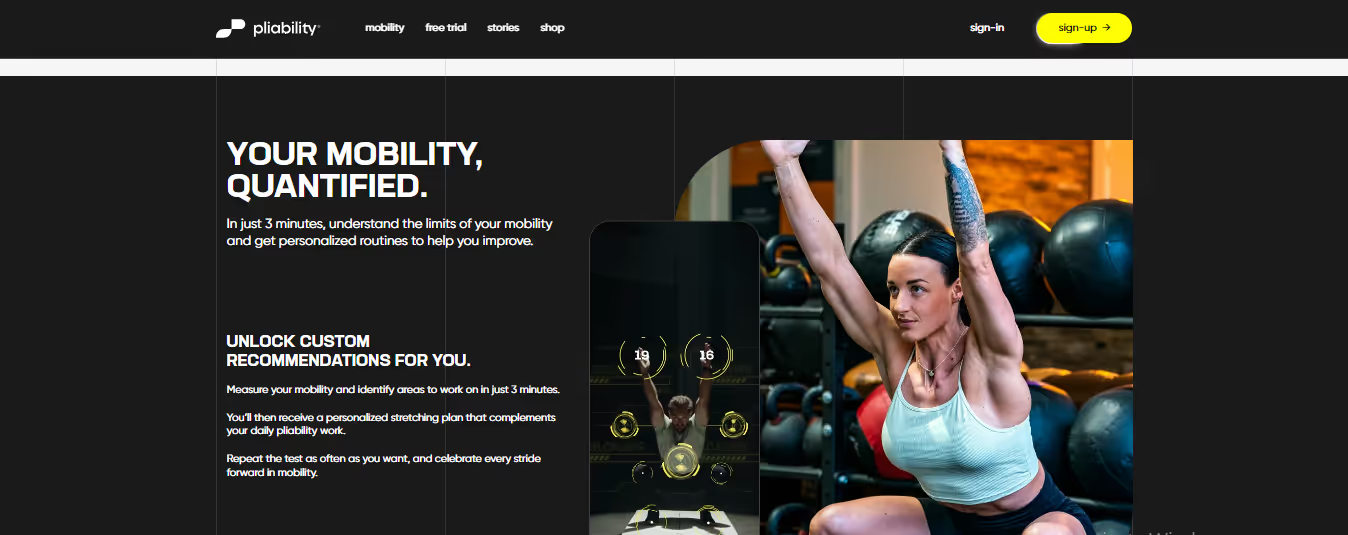
If you're feeling limited by pain or your ability to move, Pliability aims to:
- Complement your existing fitness routine
- Help you move better
Sign up today for seven days free on iPhone, iPad, Android, or our website to use our mobility app to improve flexibility, aid recovery, reduce pain, and enhance range of motion.
Related Reading
- Golf Mobility Exercises
- Upper Body Mobility Exercises
- Mobility Exercises For Runners
- Can You Over Stretch
- Squat Mobility Exercises
- Functional Mobility Exercises
- Why Stretching Is Important
- Foot Mobility Exercises
- Arm Mobility Exercises
- Elbow Mobility Exercises
- Rotator Cuff Mobility Exercises
- Bed Mobility Exercises
- What Are Mobility Exercises
- Full Body Mobility Exercises
Static vs. Dynamic Hamstring Stretches

Static stretches involve holding a single position for a set period, typically 30 to 60 seconds. Dynamic stretches incorporate active movement to stretch a muscle without any prolonged holding of a position. The goal of a dynamic stretch is to increase blood flow, get the muscles ready for activity, and improve flexibility.
Examples of static hamstring stretches include the:
- Seated hamstring stretch
- Standing hamstring stretch
- Lying hamstring stretch
Popular dynamic hamstring stretches include:
- Leg swings
- Walking lunges
- High knees
- Toe touches
Why Static and Dynamic Stretching Hamstring Stretches Are Important
Pfeifer says knowing the difference between static and dynamic stretching and when to incorporate each stretch is key to keeping the hamstrings flexible and maintaining top physical performance and health.
“An easy way to remember when to perform each stretch is to be dynamic before your workout and stay static after you’re done,” Pfeifer says.
Static Hamstring Stretching For Recovery
Static stretches are best performed following some exercise or as part of a rehab program. That’s because prolonged static stretching can cause micro-tearing of the muscle, which Pfeifer says can dampen your physical performance.
Dynamic Hamstring Stretches to Do Before Activity
She says dynamic stretching is the best way to improve muscle flexibility before exercise without detrimentally affecting performance.
6 Best Hamstring Stretches
Heather Jeffcoat, DPT, says the best hamstring stretches involve stretching in multiple fascial planes, as life is not linear and involves movement in various directions. Here are two of her favorite hamstring stretches.
Classic Hamstring Stretch
Put your left heel on a chair or curb, keeping the spine straight, and lean forward until you feel a stretch behind the thigh.
- Hold for five slow, deep breaths.
- Increase hold time as the hamstrings become more flexible.
Hamstring Stretch With a Twist
Get in the classic hamstring stretch position and rotate the spine to the left, feeling the stretch deepen on the outside of the hip and thigh.
- Hold for 5 slow deep breaths.
- Go back to the starting position and rotate the spine to right, feeling the stretch deepen on the inside of the hip and thigh.
- Hold for 5 slow, deep breaths.
- Repeat the stretch on each side 2-3 times.
- Increase hold time as the hamstrings become more flexible.
Supine Dynamic Hamstring Stretch
Pfeifer’s all-time favorite hamstring stretch is a supine dynamic hamstring stretch.
- Begin by lying on your back with your knees bent and feet flat on the floor.
- Keeping your knees bent, place your hands behind the knee on the side you wish to stretch and pull your leg towards your chest.
- While holding your leg in this position, actively straighten the leg, feeling a stretch in the back of the extended leg.
- Do 10 reps on each leg.
Standing Dynamic Hamstring Stretch (aka Hamstring Frankenstein’s)
A close second favorite for Pfeifer is the standing dynamic hamstring stretch.
- Stand with both arms by your side.
- Begin by reaching both arms in front of you at shoulder level. Kick with one leg keeping it as straight as possible trying to kick your hands.
- Keep your hands at shoulder level, torso straight, and do not bend forward.
- Repeat on the other side.
- Do 10 reps on each leg.
Supine Belted Static Hamstring Stretch
Props are an excellent way to modify a stretch. In this classic hamstring stretch, Pfeifer likes to use a belt or resistance band.
- Begin by sitting with the knee you intend to stretch straight.
- Place a belt or resistance band around your foot and hold on with both hands.
- Lay back and begin lifting yor leg up, keeping your knee straight.
- Use the belt to provide a comfortable stretch behind the back of your leg and knee.
- Hold for 30 seconds on each leg and repeat two to three times on each side.
Supine Wall Hamstring Stretch
Shoemaker likes the supine wall static stretch. When performed three times for one minute each, she says it can help improve the length of the hamstring muscles.
- Lie down on your back and scoot your hips as close to the wall as possible. Let your arms rest by your sides with palms facing up.
- Extend one leg up against the wall, keeping the other leg bent on the floor or straight if that's more comfortable. Make sure the extended leg is straight and your heel is pointing towards the ceiling.
- Keep both legs in line with your hips. You should feel a gentle stretch in your hamstring. If it's too intense, bend your knee slightly. If it's not enough, you can scoot your hips closer to the wall.
- Hold the stretch for about 30-60 seconds, gradually increasing the time as your flexibility improves.
- After holding the stretch on one leg, switch to the other side and repeat the process.
What’s the Best Way to Add Hamstring Exercises into Your Workouts?

Jermaine advises performing targeted exercises two to three times per week to improve hamstring strength and flexibility. "You can always mix in other hamstring workouts of your choosing, perhaps even those with resistance bands if you enjoy props or like to switch things up." Pairing strength and stretching routines is crucial for keeping hamstrings healthy and functioning properly.
Hamstring Mobility Exercises and Your Workout Routine
Think of hamstring stretches and strengthening exercises as vital components of your workout routine, not just something to do once you feel tightness or soreness. Jermaine suggests incorporating these moves into your lower-body and full-body strength training regimens. “By including them in both sessions, you ensure well-rounded development and minimize the risk of muscular imbalances targeting the hamstrings.”
Yet he also says you can do a dedicated hamstring workout to stabilize and boost functionality or even take things up a notch by doing a broader posterior chain (aka the back of the body) strength workout. “Hamstring-focused workouts can isolate and target these muscles more intensively, leading to improved strength and power,” Jermain continues. “It allows for specific training that might not be achievable during combined full-body or lower-body sessions, making it a valuable option for those aiming to prioritize hamstring development.”
Pairing Cardio with Hamstring Mobility Exercises
A dedicated cardio workout is just as crucial as strength training to keep your body (and overall health) in tip-top shape. That said, is it better to do hamstring exercises before or after spiking your heart rate? “Training hamstrings before cardio can help ensure they are adequately warmed up and less prone to injury during the cardio session,” Jermaine explains. “It can also promote muscle engagement and strength development.”
While this order is beneficial, that doesn’t mean that developing your hammies post-cardio is inferior. It simply offers different advantages. “Training hamstrings after cardio can be an effective way to stretch and lengthen the muscles after they've been engaged, promoting flexibility and recovery,” the Peloton instructor shares. These points considered, the ideal sequencing will depend on your personal preferences and goals. So long as you get both forms of movement in, there’s really no wrong way to go.
Progressing Hamstring Mobility Exercises Safely
If your goal is to continually build muscle, you’ll need to level up in terms of reps, sets, and or the amount of weight you use. The trick is to know when to do so and how to scale up safely. “The frequency at which a person should level up their hamstring exercises depends on their fitness level and goals,” says Jermaine. To avoid plateaus and maintain a steady challenge, he suggests the following timelines for boosting intensity as follows:
- Beginners: Adjust every 4 to 6 weeks
- Intermediate: Adjust every 6 to 8 weeks
- Advanced: Include more frequent variations every 4 to 6 weeks to advance your goals and avoid adaptation.
“Ultimately, the key is to periodically modify exercises to maintain steady gains and prevent monotony in your training routine,” Jermaine concludes. “Remember: A balanced body is a happier body, so keep working on those hamstrings for an injury-resistant you!”
Improve Your Flexibility with Our Mobility App Today | Get 7 Days for Free on Any Platform

Overstretching occurs when you push your muscles and joints beyond their limits, leading to damage instead of improvement. Though overstretch sounds simple, it can lead to painful injuries that may prevent your mobility training progress. Understanding the risks of overstretching will help you avoid it and improve your flexibility.
Related Reading
- Gowod Vs Pliability
- Tennis Mobility Exercises
- Weighted Mobility Exercises
- Cervical Mobility Exercises
- Resistance Band Mobility Exercises
- Rib Mobility Exercises
- Glute Mobility Exercises
- Best Yoga App
- Free Apps For Stretching And Flexibility
- Mobility Apps
- Stretching Apps
- Chest Mobility Exercises
- Glute Stretches
- Gluteus Medius Stretch
- Glute Stretch
- Cervical Radiculopathy Exercises

